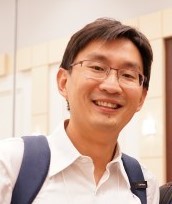Applications of
MGI Techniques in Quantum Materials Research
Kui Jin*
Institute of Physics,
Chinese Academy of Sciences, Beijing, 100190, China
ABSTRACT: In this talk, I will briefly review the
history of high-throughput research and then focus on some recent applications
in superconductivity research.
I will first
show a high-throughput process from sample preparation to data library on La2-xCexCuO4
(LCCO) superconductor, to demonstrate the concept of experimental data matching
over multiscale space. We succeeded in growing epitaxial LCCO film on 1 cm
(00l)-SrTiO3 substrate by the combinatorial laser MBE technique,
with a composition gradient from optimal superconducting phase (x =
0.10) to Fermi liquid state (x = 0.19). Such high quality combinatorial
films are suitable for multiscale fast screening, and therefore i) a
lattice-doping library is set up assisted by high-throughput in-lab XRD and
synchrotron XRD facilities, with the space resolution reduced from millimeter
down to micrometer; ii) the electrical transport database, obtained in several
weeks on a single chip, contains hundreds of resistivity data sets and helps to
verify the relation between the doping level and the superconducting transition
temperature (Tc) quantitatively; iii) information on magnetization
is also collected by two-coil mutual inductance[4] and scanning SQUID
techniques, displaying a textbook behavior of penetration depth. These
combinatorial films are being used for pump-probe, XAS, RIXS measurements, to explore
the systematical behavior without missing subtle feature.
In the second
part, I will introduce a new fabrication method to obtain high-throughput
samples, based on lattice structure modulation that is distinct from
conventional composition combinatorial methods. The core idea is the
construction of a dual-beam pulsed laser deposition (PLD) technique, which has
been successfully applied on FeSe and BaTiO3 systems. The binary
compound FeSe, simple in structure, displays complex physics properties. After
10 years of intensive research, the relation between Tc and crystal lattice
remains elusive. It is encouraging that the new method can assist in growing
FeSe film with a gradient Tc, e.g. from 0 to 12 K, of high single
crystallinity. Moreover, we extracted a Tc-lattice library on such FeSe chip
and find unambiguous relation within several weeks, which sharply contrasts the
failure to obtain such rules by fabricating more than 1000 uniform films in 3
years with the traditional single beam PLD process. Once obtaining a reference
library, we can choose the right uniform samples for a comprehensive study, and
finally verify that the Tc evolution is caused by local lattice
distortions, rather than off-stoichiometric defects or doping effect. This is a
key in understanding the nature of FeSe superconductor. Moreover, the material
aging effect as a function of time due to the evolvement of lattice
dislocations is projected to the real space axis.
Finally, I
will exhibit our homemade combi laser MBE integrated with an in-situ low
temperature STM system, a gem of 4-year effort of the team, and introduce the
Beijing Materials Genome Initiative Center and its design principles. The
high-throughput paradigm will undoubtedly become an indispensable tool in
superconductivity research in the near future.
Keywords: Combinatorial films; High-Tc superconductors; MGI center
* Corresponding author:
kuijin@iphy.ac.cn

Kui Jin obtained his Ph.D. degree in Physics from the Institute of Physics (IOP), CAS in 2008. From 2008 to 2012, he was a postdoc in the University of Maryland, College Park, USA. He started his research career in IOP and leads a group in the National Laboratory for Superconductivity. Currently, he is the deputy director of the National Lab for Superconductivity@IOP, CAS. He has been engaged in the investigation of novel superconductivity via single crystalline films and the development of high-throughput experimentation.